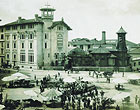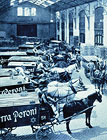Section 1
Section 2
Section 3
Section 4
G. P.: Let’s see if I’ve understood correctly: when the museum began to be coordinated by the External Relations Office, its marketing functions increased. The museum is usually a one-dimensional institution, whereas a serious cultural action aims to discover and communicate multiple dimensions. So, in your efforts, did you manage to create services for the company and therefore, actually participate in the business process by offering them organizational advantages and a streamlined flow of information? Is that a possible prospect?
 D.B.: Yes. The archives now offers improvement of the practical aspects to the advantage of the company. Marketing, for example, often makes use of the archives’ services to research the history of different brands, of company communication and of the packaging.
D.B.: Yes. The archives now offers improvement of the practical aspects to the advantage of the company. Marketing, for example, often makes use of the archives’ services to research the history of different brands, of company communication and of the packaging.
So, if someone needs to work on the restyling of “Nastro Azzurro”’s history, the archives will provide the necessary information. Also, there is frequent staff turnover in the marketing department, and the organization tends to forget past information. For this reason, I have prepared several files on the history of brands for my colleagues. This is a very useful and practical service.
In addition, we have external relations with Universities. We receive thesis students who are mainly interested in the history of the advertising message. But the basic activity remains that of a service for the company.
G.P.: Tell me more about the Archives’ relations with its users.
 D.B.: Six or seven out of ten monthly requests come from the company, the rest from external users. It is not a widely used archive, but it has got its regular users. As the Archives and the Museum are inside an industrial plant that operates round the clock, there are problems of accessibility and safety that impose limitations on external users. A couple of good examples of the Museum’s users who are connected to the company’s commercial life, would be the visit by 80 Roman sommeliers or the pizza makers who came to Rome for the Pizza Time exhibition.
D.B.: Six or seven out of ten monthly requests come from the company, the rest from external users. It is not a widely used archive, but it has got its regular users. As the Archives and the Museum are inside an industrial plant that operates round the clock, there are problems of accessibility and safety that impose limitations on external users. A couple of good examples of the Museum’s users who are connected to the company’s commercial life, would be the visit by 80 Roman sommeliers or the pizza makers who came to Rome for the Pizza Time exhibition.
It is true that the Museum and the Archives have a lot of unused potential, but since they are the property of the new ownership, it is SABMiller who decides their destiny. It’s not a question of trying to convince Top Management with theory or illustrious examples of other archives; if that year the company decides to allocate minimum maintenance and to exclude public access, that is what it will be done.
G.P.: Isn’t there an external authority, for example a scientific committee, to add their voices to a promotion of the archives to top management?
D.B.: No, there isn’t.
 G.P.: So, the museum acts as a fully integrated part of the business structure. No advisors to influence the entrepreneur or make suggestions.
G.P.: So, the museum acts as a fully integrated part of the business structure. No advisors to influence the entrepreneur or make suggestions.
D.B.: No. Only during the setting-up of the museum – which project lasted two or three years – was there a more concerted effort. A staff was appointed: there were persons in charge of technical and administrative aspects; people in charge of marketing, a scientific administrator, the presidency as a guide and a general supervisor, external architects for the exhibit layouts, etc. The planning and realization of the museum and archives was certainly the moment of greatest collaboration. At present, it wouldn’t be possible; let’s say that the museum and archives is an only child..
G.P.: On the other hand, it’s too early to comment on the new multinational ownership. The multinationals often behave badly towards the acquired companies’ historical memory, as we have seen in the case of Barilla. Perhaps it’s better to wait and see.
D.B.: Absolutely. It’s too early to say what will happen. In this field there are many different situations. Sometimes the multinational itself promotes the historical enhancement of its own brands (as we can see with Ferrarelle, Buitoni/Perugina and others). Pilsner Urquell beer of Pilsen, in the Czech Republic, is part of the group SABMiller and has quite an active museum and historical archives.
They are of course more accessible than the Peroni Museum in Tor Sapienza in Rome. However, it is
a positive sign of continuity, of respect for the brand’s historical value and of what the company has meant to the territory: it would be stupid to turn one’s back on that. Of course, time will tell.
The use of illustrations kindly granted by Archivio storico Peroni
